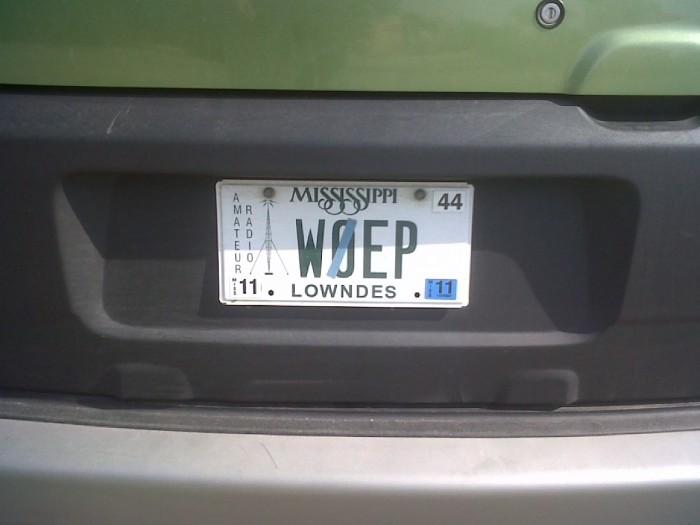[Today’s run: 7 miles with Boardtown Runners]
Today’s picture is of my amateur radio license plate.
I have a couple of comments about this.
One: Amateur radio license plates have been available for a long time, even before the recent explosion of different types of personalized plates. I think that state motor vehicle departments were well inclined toward amateur radio plates because of the role that hams play with emergency preparedness. And maybe it was easy to handle because ham callsigns are unique and are assigned by the federal government?
In my limited experience, amateur radio plates cost more than the default plates but not as much as the general personalized plates.
Two: You can see in the picture that I have put a piece of blue tape in the zero of W0EP. When I went to get my Mississippi plates I told them my callsign is w0ep and showed them my ham radio license from the FCC. They entered it into their system. They said that zero and capitol O are the same in their system. Maybe that is not a big surprise since ham radio callsigns in this region of the country usually have a 4 or a 5, not a zero. I “fixed” it by putting a piece of blue masking tape to make a slash through the zero. And that brings up another thing: why do I want to make the zero have a slash through it?
Zeros in ham callsigns traditionally have a slash or a dot in them. In the early days of radio, up until well after WW2, many hams copied morse code using a “mill” or typewriter. That is the way the professional morse code telegraphers did it. Their typewriters had only uppercase and the zero had a slash through it to distinguish it from the letter O.
Something kind of similar happened when teletype machines came along, they were all uppercase too. In fact they didn’t have a full keyboard, only three rows of keys. There were keys labeled “FIGS” and “LTRS” which would let you shift into “figures” or numbers/puntcuation mode then back to letters mode. Typing my callsign on one of those would be W <FIGS> O <LTRS> E P. But the reason they did that was because the machine coding for those teletype machines was a 5 bit code and did not have enough values to cover the alphabet and the numbers/punctuation all in one set of codes. So they doubled it up by having two modes. Here is the Wikipedia article aboutTeleprinters which explains about that.
